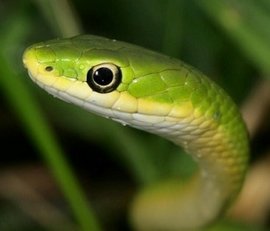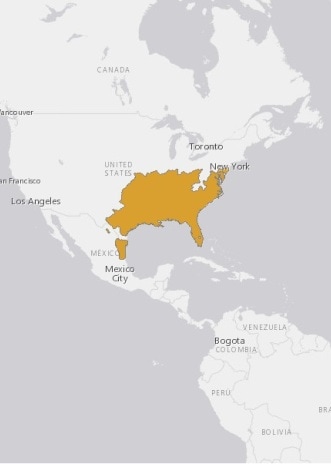Rough Green SnakeOpheodrys aestivus |

Custom Search
|
Although commonly present in the Piedmont and Atlantic coastal plain the species is absent from the higher elevations of the Appalachian Mountains. A small population has been found in New Mexico.
The rough green snake is also found in the Mexican states of Tamaulipas and eastern Nuevo León. They inhabit a variety of habitats but are most commonly found in open forests, woodlands and moist meadows, most often near water along the margins of wetlands and rivers. Even though they are definitely highly arboreal snakes they are also often found on the ground, routinely foraging in thick vegetation along shorelines during the daytime. During the night they can often be observed sleeping coiled in thick vegetation, shrubs, bushes or vine tangles. The rough green snake is a rather long species, reaching as long as 46 inches (116 cm), although the average length is around 20 to 32 inches (50 to 81 cm). They are quite slender typically barely 1 inch or even much less in diameter. Their upper body is a uniform bright green while the belly, chin, and labial scales are yellow, cream or whitish. Since they spend much of their life moving through vegetation, this coloration forms an awesome camouflage against the green vegetation.When they die their typical bright green color fades to a bluish or black color and dead specimens may look like a small black racer. Females are slightly larger than males and juvenile rough green snake resembles adult specimens except for their paler appearance. Like their common name suggests they have keeled dorsal scales. They also have rather large eyes by comparison with to their overall size.

Rough green snakes are docile and seldom bite, when encountered by humans they often freeze allowing for a close approach. Even if they do bite they have no venom and are harmless to humans.
The rough green snake has an average lifespan of 5 years in the wild, but they can reach up to 8 years. These snakes fall prey to many predators including larger snakes like black racers or king snakes, birds, domestic cats, and even spiders. They are also known by many other common names green whip snake, bush snake, green summer snake, green tree snake, huckleberry snake, keel-scaled green snake, magnolia snake and vine snake. The species also shares common names like grass snake or green grass snake with their American relative the smooth green snake (Opheodrys vernalis). The colubrid species commonly called grass snake (Natrix natrix) found in Europe is completely unrelated. Subspecies / Taxonomy There are 2 subspecies currently recognized by scientists. Northern rough green snake (Opheodrys aestivus aestivus - Linnaeus, 1766) - Found throughout their range, except Florida. They have more of a whitish underside. Florida rough green snake (Opheodrys aestivus carinatus - Grobman, 1984) - As the name implies it's found in Florida, being one of 44 non-venomous Florida snake species. This subspecies as a more yellowish underside. Diet / Feeding The rough green snake feeds primarily on insects such as crickets, grasshoppers, caterpillars. But sometimes they will also eat snails, spiders, moths and even small frogs. These non-venomous snakes don't constrict their prey they simply grab it with their small recurved teeth and then swallow it alive. They actively hunt in trees and shrubs using their excellent vision to find and track down prey. Reproduction The rough green snake breeding season occurs in spring, but sometimes they breed again in the fall. These snakes are oviparous, meaning female snakes lay eggs. The females lay 2 to 12 very elongated eggs in mid to late summer, during June or July The eggs are laid in damp areas usually in a stump or rotting log, under bark, deep mulch, under a rock or tree hollow. Sometimes they use a communal nest shared by several females, up to 75 eggs have been found these nests. The hatchlings are born in August or September, after an incubation period of 6 to 12 weeks and are around 6 to 8 inches (15–20 cm) long. At first, the young snakes are grayish to pale green in color, only later do they get their characteristic bright, leaf-green color. The rough green snake males reach sexual maturity at 21 months while females need from 21 to 33 months. Conservation / Threats In general, the rough green snake has no major threats and is considered widespread. The species is listed as "Least Concern" by the IUCN due to their large and probably relatively stable population size. But with urban development leading to the clearing of wooded wetlands and vegetation near waterways and aquatic habitats may have a negative impact on their numbers at least locally. Another threat is the use of pesticides in their habitats, since they may be susceptible to poisoning because they eat mostly insects. Many are also victims of road kill. The rough green snake is also one of the most exploited in the exotic pet trade, hundreds are collected each year from the wild, because of their cheap price, around 8 US dollars. These snakes are probably effectively protected in the United States national parks and wildlife refuges. However, more information is needed regarding the species population, biology, range and threats.
|
Scientific Classification |
© 2014 Snake Facts About Us | Privacy Policy | Contact




